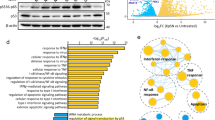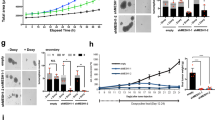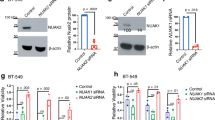Abstract
Cell growth is promoted by mitogens and survival factors, which activate intracellular signalling pathways to control cell cycle progression and cellular integrity. Proliferation signals are transmitted through Ras and Rho family small G-proteins coupled to mitogen-activated protein kinase (MAPK) cascades, while survival signals are propagated by lipid-dependent kinases such as phosphatidylinositide 3-kinases (PI3Ks) and protein kinase B (Akt/PKB). Recently, signal transducer and activator of transcription (STAT) proteins were identified as positive regulators of proliferation in a variety of cell types. Persistent activation of these pathways is associated with tumour cell growth, whereas their inhibition can halt proliferation and precipitate apoptotic cell death. The human pathogen Pseudomonas aeruginosa uses quorum-sensing signal molecules (QSSMs) to regulate virulence gene expression. QSSMs also suppress host immune responses although the mechanism of suppression is unknown. Here, we demonstrate that the QSSM N-(3-oxododecanoyl)-L-homoserine lactone (OdDHL) from P. aeruginosa blocks proliferation and induces apoptosis in human BC cell lines. Analyses of signalling events reveal that OdDHL has little or no effect on MAPK cascades, partially inhibits the Akt/PKB pathway and ablates STAT3 activity. Pharmacological inhibition of each pathway independently indicates that STAT3 activity is critical for BC cell proliferation and survival, while a constitutively active STAT3 confers resistance to OdDHL. These results support the notion of OdDHL as a bioactive molecule in eukaryotic systems and a paradigm for a novel class of antiproliferative compounds.
This is a preview of subscription content, access via your institution
Access options
Subscribe to this journal
Receive 50 print issues and online access
$259.00 per year
only $5.18 per issue
Buy this article
- Purchase on Springer Link
- Instant access to full article PDF
Prices may be subject to local taxes which are calculated during checkout







Similar content being viewed by others
References
Bild AH, Turkson J and Jove R . (2002). EMBO J., 21, 3255–3263.
Bowman T, Garcia R, Turkson J and Jove R . (2000). Oncogene, 19, 2474–2488.
Bromberg J and Darnell JEJ . (2000). Oncogene, 19, 2468–2473.
Bromberg JF, Wrzeszczynska MH, Devgan G, Zhao Y, Pestell RG, Albanese C and Darnell JEJ . (1999). Cell, 98, 295–303.
Burke WM, Jin X, Lin H, Huang M, Liu R, Reynolds RK and Lin J . (2001). Oncogene, 20, 7925–7934.
Catlett-Falcone R, Landowski TH, Oshiro MM, Turkson J, Levitzki A, Savino R, Ciliberto G, Moscinski L, Fernandez-Luna JL, Nunez G, Dalton WS and Jove R . (1999). Immunity, 10, 105–115.
Deveraux QL, Roy N, Stennicke HR, Van Arsdale T, Zhou Q, Srinivasula SM, Alnemri ES, Salvesen GS and Reed JC . (1998). EMBO J., 17, 2215–2223.
Garcia R, Bowman TL, Niu G, Yu H, Minton S, Muro-Cacho CA, Cox CE, Falcone R, Fairclough R, Parsons S, Laudano A, Gazit A, Levitzki A, Kraker A and Jove R . (2001). Oncogene, 20, 2499–2513.
Gooch JL and Yee D . (1999). Cancer Lett., 144, 31–37.
Haan S, Kortylewski M, Behrmann I, Müller-Esterl W, Heinrich PC and Schaper F . (2000). Biochem. J., 345, 417–421.
Hasegawa T, Suzuki K, Sakamoto C, Ohta K, Nishiki S, Hino M, Tatsumi N and Kitagawa S . (2003). Blood, 101, 1164–1171.
Hirano T, Ishihara K and Hibi M . (2000). Oncogene, 19, 2548–2556.
Kölch W . (2000). Biochem. J., 351, 289–305.
Kotenko SV and Pestka S . (2000). Oncogene, 19, 2557–2565.
Lackmann M, Harpur AG, Oates AC, Mann RJ, Gabriel A, Meutermans W, Alewood PF, Kerr IM, Stark GR and Wilks AF . (1998). Growth Factors, 16, 39–51.
Li L and Shaw PE . (2002). J. Biol. Chem., 277, 17397–17405.
Lin TS, Mahajan S and Frank DA . (2000). Oncogene, 19, 2496–2504.
Liu H, Ma Y, Cole SM, Zander C, Chen KH, Karras J and Pope RM . (2003). Blood, 102, 344–352.
McGahon MA, Nishioka WK, Martin SJ, Mahboubi A, Cotter TG and Green DR . (1995). J. Biol. Chem., 270, 22625–22631.
Meyer T, Begitt A, Lodige I, van Rossum M and Vinkemeyer U . (2002). EMBO J., 21, 344–354.
Mochizuki T, Kitanaka C, Noguchi K, Muramatsu T, Asai A and Kuchino Y . (1999). J Biol Chem, 274, 18659–18666.
Ndubuisi MI, Guo GG, Fried VA, Etlinger JD and Sehgal PB . (1999). J. Biol. Chem., 274, 25499–25509.
Pesci EC, Pearson JP, Seed PC and Iglewski BH . (1997). J. Bacteriol., 179, 3127–3132.
Pruitt K and Der CJ . (2001). Cancer Lett., 171, 1–10.
Reddy EP, Korapati A, Chaturvedi P and Rane S . (2000). Oncogene, 19, 2532–2547.
Robinson MJ and Cobb MH . (1997). Curr. Opin. Cell Biol., 9, 180–186.
Seidel HM, Lamb P and Rosen J . (2000). Oncogene, 19, 2645–2656.
Shen Y, Devgan G, Darnell JEJ and Bromberg JF . (2001). Proc. Natl. Acad. Sci. USA, 98, 1543–1548.
Shirogane T, Fukada T, Muller JM, Shima TD, Hibi M and Hirano T . (1999). Immunity, 6, 709–719.
Simon AR, Vikis HG, Stewart S, Fanburg BA, Cochran BH and Guan K-L . (2000). Science, 290, 144–147.
Smith RS, Harris SG, Phipps R and Iglewski B . (2002). J. Bacteriol, 184, 1132–1139.
Smithgall TE, Briggs SD, Schreiner S, Lerner EC, Cheng H and Wilson MB . (2000). Oncogene, 19, 2612–2618.
Telford G, Wheeler D, Williams P, Tomkins PT, Appleby P, Sewell H, Stewart GSAB, Bycroft BW and Pritchard DI . (1998). Infect. Immun., 66, 36–42.
Turkson J and Jove R . (2000). Oncogene, 19, 6613–6626.
Turkson JTB, Adnane J, Zhang Y, Djeu JY, Sekharam M, Frank DA, Holzman LB, Wu J, Sebti S and Jove R . (1999). Mol. Cell. Biol., 19, 7519–7528.
Vanhaesebrook B and Alessi DR . (2000). Biochem. J., 346, 561–576.
Wagner BJ, Hayes TE, Hoban CJ and Cochran BH . (1990). EMBO J., 9, 4477–4484.
Winson MK, Camara M, Latifi A, Foglino M, Chhabra SR, Daykin M, Bally M, Chapon V, Salmond GP, Bycroft BW, Lazdunski A, Stewart GS and Williams P . (1995). Proc. Natl. Acad. Sci. USA, 92, 9427–9431.
Yamauchi T, Yamauchi N, Ueki K, Sugiyama T, Waki H, Miki H, Tobe K, Matsuda S, Tsushima T, Yamamoto T, Fujita T, Taketani Y, Fukayama M, Kimura S, Yazaki Y, Nagai R and Kadowaki T . (2000). J. Biol. Chem., 275, 33937–33944.
Acknowledgements
We thank Drs Cliff Murray, Charles Strueli and Sue Watson for the provision of cells, Drs Jim Darnell and Curt Horwath for the STAT3 expression vectors and Drs Adrian Robins, Lian Zhao and Julie Swales for assistance with the flow cytometry. We are also grateful to members of the group for discussions, to Drs Fred Sablitzsky and Jim Darnell for commenting on the manuscript and to Wendy Solis for secretarial assistance. This work was supported, in part, by grants from the AICR (to PES) and the MRC (to DP).
Author information
Authors and Affiliations
Corresponding author
Additional information
Supplementary Information accompanies the paper on Oncogene website (http://www.nature.com/onc).
Supplementary information
Rights and permissions
About this article
Cite this article
Li, L., Hooi, D., Chhabra, S. et al. Bacterial N-acylhomoserine lactone-induced apoptosis in breast carcinoma cells correlated with down-modulation of STAT3. Oncogene 23, 4894–4902 (2004). https://doi.org/10.1038/sj.onc.1207612
Received:
Revised:
Accepted:
Published:
Issue Date:
DOI: https://doi.org/10.1038/sj.onc.1207612
Keywords
This article is cited by
-
It is the time for quorum sensing inhibition as alternative strategy of antimicrobial therapy
Cell Communication and Signaling (2023)
-
3-oxo-C12:2-HSL, quorum sensing molecule from human intestinal microbiota, inhibits pro-inflammatory pathways in immune cells via bitter taste receptors
Scientific Reports (2022)
-
Detection of gut microbiota and pathogen produced N-acyl homoserine in host circulation and tissues
npj Biofilms and Microbiomes (2021)
-
Prevention of biofilm formation by quorum quenching
Applied Microbiology and Biotechnology (2020)
-
Pseudomonas aeruginosa ExoS Induces Intrinsic Apoptosis in Target Host Cells in a Manner That is Dependent on its GAP Domain Activity
Scientific Reports (2018)



